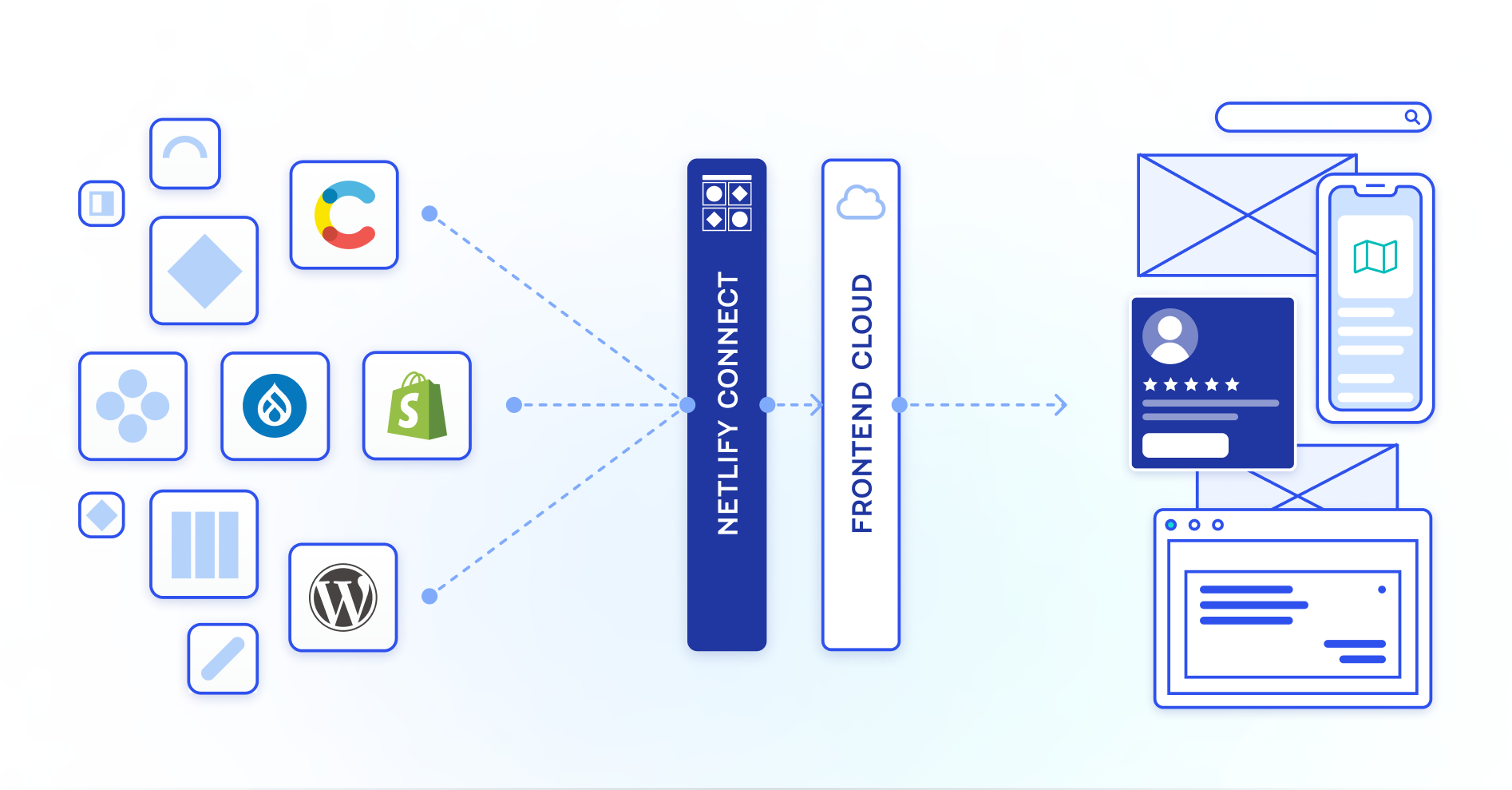Netlify Connect overview
With Netlify Connect, you can integrate content from multiple sources into a single data unification layer for easy access through a GraphQL API. Data updates sync automatically to ensure your sites and other web properties always have access to the latest content, all cached at the edge.

When you unify your content sources through Connect, you unlock a number of benefits that make it easier to modernize your web architecture:
A single data unification layer that is cached at the network edge and is optimized for global availability, reliability, and performance
No-code integrations that allow you to use data from legacy systems alongside data from your modern CMS
The ability to create private data integrations that allow you to use data from your proprietary systems
A scalable GraphQL API that allows you to use CMS providers without having to worry about the CMS API’s rate-limiting or expensive bandwidth usage limits
Flexibility to access data through the GraphQL API with any frontend framework — including Remix, Next.js, Gatsby, Vue, Svelte, and Astro
Multiple data revisions cached for each data layer that capture the GraphQL schema and data at a point in time, with the ability to pin a specific revision for your API to use while planning for a major release or troubleshooting an error
The ability to specify cross-references between data sources and retrieve combined data through a single query for a faster user experience and better developer experience
Reduced web architecture migration risk with a modular approach that allows you to create data redundancy (by caching data in Connect) and then change or update architecture components over time
Individual integrations versus Connect
Connect is an Enterprise-only feature that’s best for those who have data spread across multiple data sources. If you want to sync data from a single data source, we recommend you review our individual integrations instead, including our Contentful integration.
# Supported data sources
Connect supports the following data source types:
- Contentful
- Contentstack
- DatoCMS
- Drupal
- Sanity
- Shopify
- WordPress
- Custom — third-party or proprietary data sources supported by private or partner data integrations built with the Netlify SDK
Build support for your custom data source with the Netlify SDK
Use the Netlify SDK to develop a data integration for Connect. Data integrations use the Connectors component to specify the data model and logic for syncing data from a third-party or proprietary data source. Once you publish your data integration, users can select it in Connect to configure and start syncing data.
# Enable Connect
To enable Connect, contact our sales team to request a demo.
Once enabled, the
page will be unlocked in the Netlify UI for your team.# Get started
Once a Sales team member has enabled Connect for your team, here’s how to get started:
- Create your first data layer with at least one data source and site connected.
- Monitor the events as we complete the initial data sync for your new data layer.
- Use the GraphQL sandbox to create and test queries against your data layer.
- Generate an API token to use in all requests to the GraphQL API.
- Add code to your site to query the GraphQL API for your data layer and use the results in your site. For a better user and developer experience, use the Connect client for your queries.
- Modify content in your data source, review the data sync event, and confirm that your connected sites rebuild to get the latest data.
- Go back and edit your data layer to add more data sources and add cross-references. If you need to, you can also access different data revisions and pin a specific revision for your API to use. You can also add API scopes to restrict access to certain data and then generate new API tokens to access that data.
Repeat the above steps to add additional data layers, as needed.
# Limitations
- Connect logs are retained for 5 days. All sync events are listed in the Activities section but the logs are currently retained for only five days.
- Data revisions are retained for 60 days. All data revisions are deleted after 60 days, except for the data revision that the API is currently using (by default or as a result of pinning).
- Continuous deployment is required for site updates. For Netlify to automatically build and deploy your site when data changes, your site must be linked to a Git repository to enable continuous deployment, and it must have active builds.
- Data changes trigger only production branch builds for connected sites. When data changes in your data layer, Netlify automatically builds and deploys the production branch of all connected sites. Currently, it’s not possible to specify a different branch to connect. But, you can use custom webhooks as a workaround.
- Responses to large queries do not get cached. If your query is larger than 10 KiB (10240 bytes), the response will not be cached at the edge. Learn more about how to adjust your queries to ensure the responses are cached and data is returned faster.
# More Connect resources
Did you find this doc useful?
Your feedback helps us improve our docs.